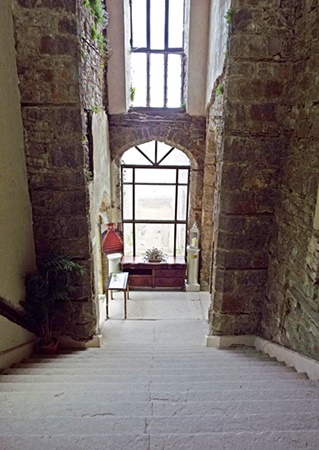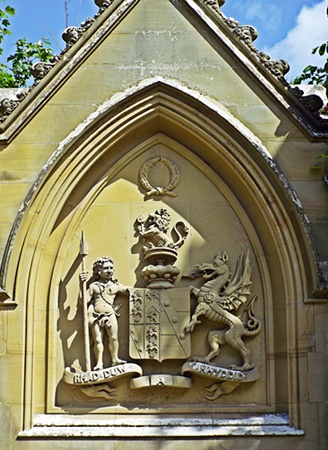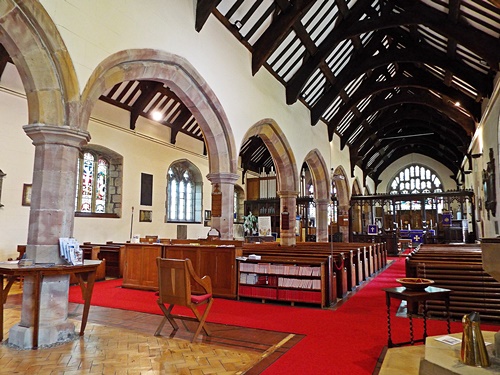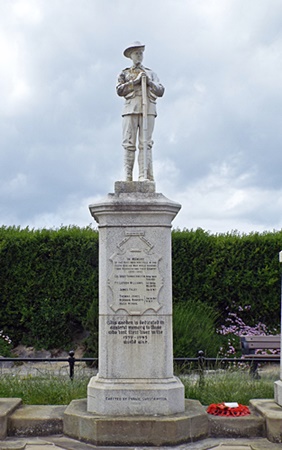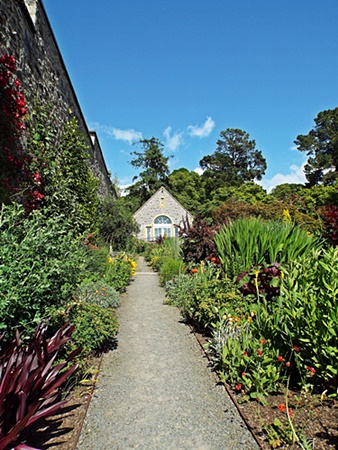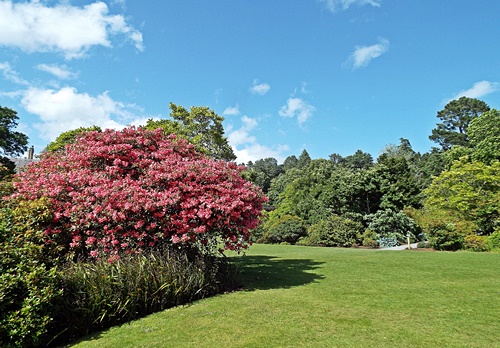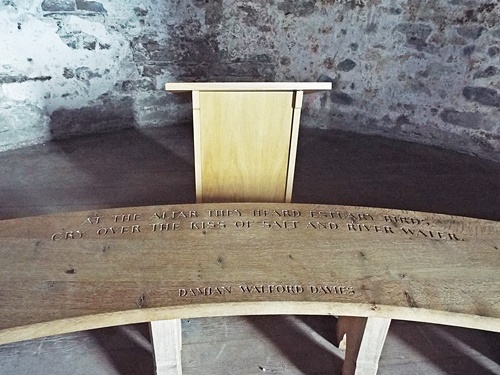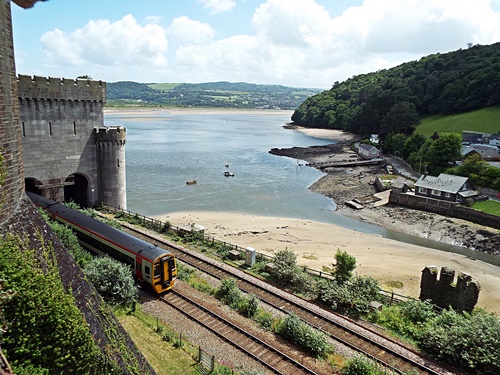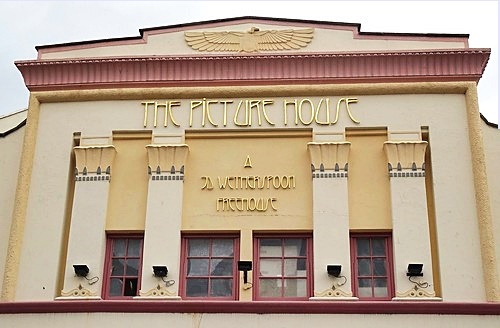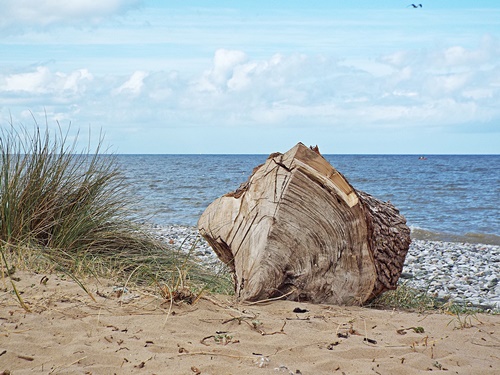It was another dull morning with lots of grey cloud around and the wind still blowing a hooley but with one or two patches of blue sky showing through there was a chance it would brighten up later on. I was nearing the end of the holiday though and I didn’t want to waste the day by staying on site so I took myself off to visit Gwrych Castle in Abergele.
The fascinating history of Gwrych Castle and its long line of owners dates back to 1485 and the Lloyds, a family with impressive ancestry and whose seat was Gwrych House, Abergele. Three hundred years later Frances Lloyd, heiress to the Gwrych estate, married Robert Bamford-Hesketh of Chester in 1786 and in 1788 their first son, Lloyd Hesketh Bamford-Hesketh, was born. Frances died in 1797 when Lloyd was only nine years old and his father Robert subsequently rented out Gwrych House and moved the family to Chester, though he and Lloyd eventually moved back to the house in 1809.
From a very early age Lloyd had been fascinated by castles and after developing an interest in medieval architecture he made it his ambition to create a castle on the hillside behind the house as a monument to his mother and his Welsh ancestors. In December 1814 he embarked on a Grand Tour of Europe during which he made sketches of the architecture in some of the towns and villages he passed through but his travels were cut short in 1815 when his father died. Inheriting the whole of the Gwrych estates, which stretched across North Wales into north west England, meant inheriting a great responsibility so any plans to create a castle were put on hold and it wasn’t until December that Lloyd’s attention returned to building his new family seat.
Having sketched several designs of his own for his proposed vision Lloyd wasn’t confident enough to use them to turn his ideas into reality so he commissioned Charles Augustus Busby to produce a plan and sketch of a castellated mansion. Although Lloyd initially liked Busby’s design he felt it was too plain and nothing like the Gothic Revival castle he envisioned so in 1816, after drastically altering Busby’s plan with ideas of his own, he employed Liverpool-based architect Thomas Rickman, an authority on medieval architecture, to advise on Gothic window design. Rickman submitted several designs for cast iron windows though rather than choose one particular window pattern Lloyd picked elements of each design to create a new pattern which would be to his own taste and unique to Gwrych.
During 1818 the final plan for Gwrych was formulated, influenced by both Busby and Rickman, but it was Lloyd’s own ideas which produced the final development – without his direction and intense involvement in every step of the process Gwrych would probably have been just like any other Regency castellated mansion which can be seen throughout Wales and the rest of the UK. Work on the castle and outbuildings began in 1819, with the ‘official’ foundation stone being laid for the main house on June 13th that year. By 1822 most of the work was complete and Lloyd began furnishing the interiors and laying out the gardens, though over the next thirty years he also added towers, walls and battlements to the property, enlarging and developing what eventually became the largest built structure in Europe until the Crystal Palace was built for the Great Exhibition in 1851.

In 1825 Lloyd had married Lady Emily Esther Ann Lygon, youngest daughter of the 1st Earl of Beauchamp, with their eldest son Robert Bamford-Hesketh, named after Lloyd’s father, being born at Gwrych a year later. At the age of 25 Robert married Ellen Jones-Bateman of Pentre Mawr, Abergele, in 1851, thus uniting two gentry families, and in 1859 Winifred, their only surviving child, was born. Lloyd died in 1861 at the age of 73 with Robert subsequently inheriting Gwrych Castle and its estate, and over the years he and Ellen planted much of the present gardens with their enormous monkey puzzle and yew trees.
In 1878, at the age of 19, Winifred had an arranged marriage to Lieutenant General Douglas Cochrane, and in 1880 the first of their five children, Lady Grizel Cochrane, was born and brought to Gwrych Castle. Sadly the marriage wasn’t entirely a happy one and as a consequence Douglas spent much of his time either in Scotland or away fighting wars whilst his wife and subsequent children remained in her Welsh homeland, meaning that the two led increasingly separate lives. In 1885 Douglas became the 12th Earl of Dundonald when his father died, with Winifred becoming Countess of Dundonald, then in 1894 her own father Robert died at the age of 68 followed by her mother Ellen in 1902, with Gwrych Castle and its estates passing to Winifred.
Robert had provided in Winifred’s marriage settlement that the family’s wealth and land was hers alone to use or dispose of however she wished so following in her father’s footsteps after his death she chose to run her inherited estates herself with the help of an agent, resulting in her husband having little, if anything, to do with her affairs. By 1904 the two were virtually estranged and by 1906 the marriage was over, and though Winifred stopped short of divorce the Earl was banned from Gwrych, a fact which was to become significant in later years.

Throughout her years at Gwrych Winifred made many changes, refurbishments and additions to the castle including a wide 52-step marble staircase designed by architect Detmar Blow and installed in 1914. She was a remarkable woman, being an advocate for both womens’ rights and animal rights, championing many causes and financing many projects including the building of Abergele drill hall and the village hall in nearby Llanddulas. She donated land to build Colwyn Bay Community Hospital and in 1916 set up a Prisoner of War camp at Llansannon and a military hospital in London. The First World War took its toll on her however – she developed diabetes and died suddenly from heart failure in 1924.
Gwrych Castle was bequeathed to the then Prince of Wales as a royal residence but the bequest was declined and the property passed to the Church in Wales, of which Winifred had been one of its founding members in 1920, however to spite his wife in death the castle was re-purchased in 1928 by the Earl of Dundonald who sold the contents to meet the £70,000 cost. He claimed that Winifred had gone mad before her death and declared that no member of the family would ever live there again – and none ever did. The Earl himself died seven years later at his home in Wimbledon in April 1935 aged 82 and was succeeded by his and Winifred’s elder son Thomas who then became the 13th Earl of Dundonald.
The sale of the castle contents in 1928 started a decline in Gwrych as it lay virtually empty for the next twenty years although in 1939 the Government did, as an emergency measure, requisition the property from Thomas, the 13th Earl, to house up to 300 Jewish refugee children brought to Britain as part of Operation Kindertransport after being separated from their families. The children left Gwrych at the end of the war when they had the chance of being reunited with their relatives and in 1946 the castle and estate were sold by Thomas to Robert Jesse Rennie for £12,000, meaning that for the first time in nearly 1,000 years the lands had not been owned by a member of the Lloyd family.
Following the sale the estate was broken up – at the castle itself trees were felled in the woodlands and the vast parkland became subdivided farmland in multiple ownership. Two years later the castle was sold again, this time to entrepreneur Leslie Salts who laid new paths and a car park alongside the lower drive. The main rooms were refurnished, the original stables were converted into a cafe, a miniature railway was laid and a childrens’ zoo developed. As the ‘Showplace of Wales’ Gwrych was one of the first country houses in Britain to be opened to the public as an attraction and for the next twenty years it continued as a very prosperous business employing over 200 people and attracting nearly ten million visitors. By the late 1960s however Leslie Salts felt that the expectations of the public were changing so in 1968 he decided to sell the castle and retire.
Gwrych was purchased by a London-based development company but with the estimated cost of restoring the castle to its former glory being well beyond the company’s budget it was decided to put little money into the fabric and as much as possible into the entertainment content. The formal gardens were cleared and structures bulldozed to make way for a medieval jousting arena, the ‘Knights of Gwrych’ were formed as a permanent entertainment troupe and the Principality of Gwrych was created. Between 1972 and 1987 jousting tournaments, medieval banquets, markets and a bar operated in and around the castle but nothing was paid into the preservation of the building and by December 1985 the venture was deemed to be a lost cause, with only the bar and jousts in operation. The last jousting tournament was held in 1987 and the castle closed to the public in 1988.
In 1989 Gwrych was sold to an American businessman for £750,000 but his plans to restore the castle were never realised; it fell victim to vandalism, looting and arson and was left to decay. In 1994 the site became an illegal encampment for ‘New Age Travellers’ who stripped the lead and slates from the roof, sold off internal fittings and burnt the floorboards on bonfires, while local dealers stole architectural items like fireplaces which ended up in reclamation yards. It was eighteen months before the travellers were evicted but by then the castle had been reduced to little more than a roofless shell. Further damage was caused to the grounds in 1996 when they were used as a film set by Constantine Films for the filming of Prince Valiant – much of the slope in front of the castle was excavated and though it was later re-landscaped and restored to grass it was nothing like the gentle slope constructed by Lloyd Hesketh Bamford-Hesketh 150 years earlier.


Heading into the present day Mark Baker, an 11-year old schoolboy who passed the castle daily and played around its walls, found its destruction so appalling that he decided to do something about it and in 1997, aged just 12, he founded the Gwrych Castle Preservation Trust with the aim of restoring the castle and making it accessible to visitors once more. The condition of the castle was monitored by the Trust and in 2006 lobbying Conwy Council to compulsorily purchase the property put pressure on the absentee American owner to put it up for sale. It was bought for £850,000 by City Services Ltd, trading as Clayton Hotels, and in 2007 they proposed a £6m project to convert Gwrych into a 90-bedroom 5-star hotel; the project was subject to planning permission but had the support of the Trust.
Significant sums were spent by Clayton Hotels on plans and partially clearing the site but work was halted by the credit crunch in 2008 and in 2009 the company went into administration. The following year the castle was purchased by another development company and in 2012 planning permission was obtained for a 75-bed luxury hotel but with the company unable to secure the considerable funds needed to invest in such a major renovation the project never got off the ground.
Although the future of the castle itself remained uncertain the Trust was eventually able to lease part of the site from the development company and the gardens and some of the outbuildings began to see a period of revival under the care of its members. In August 2016 a special open weekend was held to celebrate the life and achievements of world champion boxer Randolph Turpin who lived and trained at the castle in the early 1950s, then in 2017 the gardens were opened to the public on a daily basis. In June 2018 the castle and its immediate estate were sold to the Trust, it’s purchase enabled by a massive grant from the National Heritage Memorial Fund, and its future was finally secure.
































